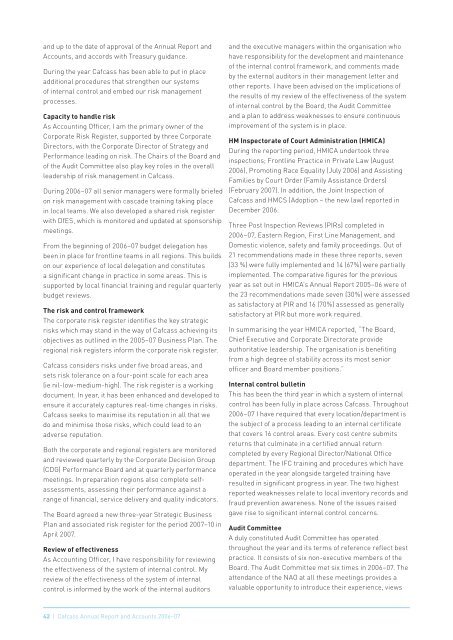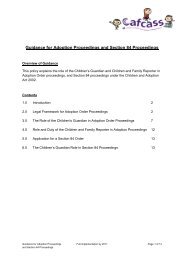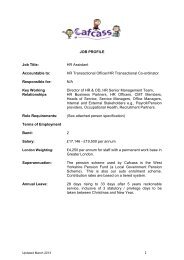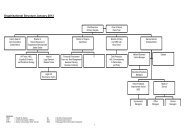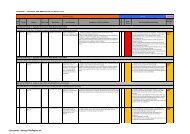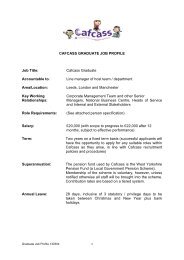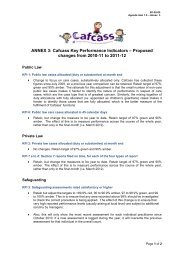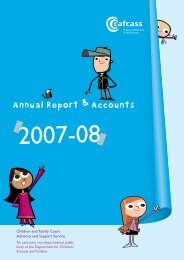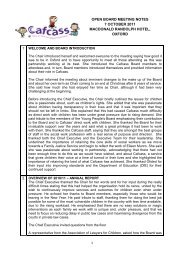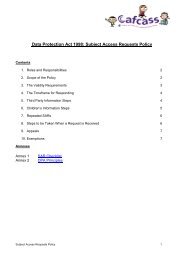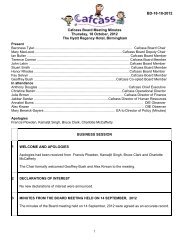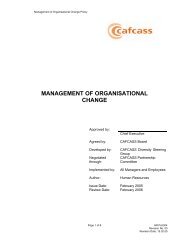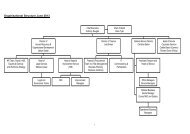Annual Report 2006-2007 - Cafcass
Annual Report 2006-2007 - Cafcass
Annual Report 2006-2007 - Cafcass
Create successful ePaper yourself
Turn your PDF publications into a flip-book with our unique Google optimized e-Paper software.
and up to the date of approval of the <strong>Annual</strong> <strong>Report</strong> and<br />
Accounts, and accords with Treasury guidance.<br />
During the year <strong>Cafcass</strong> has been able to put in place<br />
additional procedures that strengthen our systems<br />
of internal control and embed our risk management<br />
processes.<br />
Capacity to handle risk<br />
As Accounting Officer, I am the primary owner of the<br />
Corporate Risk Register, supported by three Corporate<br />
Directors, with the Corporate Director of Strategy and<br />
Performance leading on risk. The Chairs of the Board and<br />
of the Audit Committee also play key roles in the overall<br />
leadership of risk management in <strong>Cafcass</strong>.<br />
During <strong>2006</strong>–07 all senior managers were formally briefed<br />
on risk management with cascade training taking place<br />
in local teams. We also developed a shared risk register<br />
with DfES, which is monitored and updated at sponsorship<br />
meetings.<br />
From the beginning of <strong>2006</strong>–07 budget delegation has<br />
been in place for frontline teams in all regions. This builds<br />
on our experience of local delegation and constitutes<br />
a significant change in practice in some areas. This is<br />
supported by local financial training and regular quarterly<br />
budget reviews.<br />
The risk and control framework<br />
The corporate risk register identifies the key strategic<br />
risks which may stand in the way of <strong>Cafcass</strong> achieving its<br />
objectives as outlined in the 2005–07 Business Plan. The<br />
regional risk registers inform the corporate risk register.<br />
<strong>Cafcass</strong> considers risks under five broad areas, and<br />
sets risk tolerance on a four-point scale for each area<br />
(ie nil-low-medium-high). The risk register is a working<br />
document. In year, it has been enhanced and developed to<br />
ensure it accurately captures real-time changes in risks.<br />
<strong>Cafcass</strong> seeks to maximise its reputation in all that we<br />
do and minimise those risks, which could lead to an<br />
adverse reputation.<br />
Both the corporate and regional registers are monitored<br />
and reviewed quarterly by the Corporate Decision Group<br />
(CDG) Performance Board and at quarterly performance<br />
meetings. In preparation regions also complete selfassessments,<br />
assessing their performance against a<br />
range of financial, service delivery and quality indicators.<br />
The Board agreed a new three-year Strategic Business<br />
Plan and associated risk register for the period <strong>2007</strong>–10 in<br />
April <strong>2007</strong>.<br />
Review of effectiveness<br />
As Accounting Officer, I have responsibility for reviewing<br />
the effectiveness of the system of internal control. My<br />
review of the effectiveness of the system of internal<br />
control is informed by the work of the internal auditors<br />
and the executive managers within the organisation who<br />
have responsibility for the development and maintenance<br />
of the internal control framework, and comments made<br />
by the external auditors in their management letter and<br />
other reports. I have been advised on the implications of<br />
the results of my review of the effectiveness of the system<br />
of internal control by the Board, the Audit Committee<br />
and a plan to address weaknesses to ensure continuous<br />
improvement of the system is in place.<br />
HM Inspectorate of Court Administration (HMICA)<br />
During the reporting period, HMICA undertook three<br />
inspections; Frontline Practice in Private Law (August<br />
<strong>2006</strong>), Promoting Race Equality (July <strong>2006</strong>) and Assisting<br />
Families by Court Order (Family Assistance Orders)<br />
(February <strong>2007</strong>). In addition, the Joint Inspection of<br />
<strong>Cafcass</strong> and HMCS (Adoption – the new law) reported in<br />
December <strong>2006</strong>.<br />
Three Post Inspection Reviews (PIRs) completed in<br />
<strong>2006</strong>–07, Eastern Region, First Line Management, and<br />
Domestic violence, safety and family proceedings. Out of<br />
21 recommendations made in these three reports, seven<br />
(33 %) were fully implemented and 14 (67%) were partially<br />
implemented. The comparative figures for the previous<br />
year as set out in HMICA’s <strong>Annual</strong> <strong>Report</strong> 2005–06 were of<br />
the 23 recommendations made seven (30%) were assessed<br />
as satisfactory at PIR and 16 (70%) assessed as generally<br />
satisfactory at PIR but more work required.<br />
In summarising the year HMICA reported, “The Board,<br />
Chief Executive and Corporate Directorate provide<br />
authoritative leadership. The organisation is benefiting<br />
from a high degree of stability across its most senior<br />
officer and Board member positions.”<br />
Internal control bulletin<br />
This has been the third year in which a system of internal<br />
control has been fully in place across <strong>Cafcass</strong>. Throughout<br />
<strong>2006</strong>–07 I have required that every location/department is<br />
the subject of a process leading to an internal certificate<br />
that covers 16 control areas. Every cost centre submits<br />
returns that culminate in a certified annual return<br />
completed by every Regional Director/National Office<br />
department. The IFC training and procedures which have<br />
operated in the year alongside targeted training have<br />
resulted in significant progress in year. The two highest<br />
reported weaknesses relate to local inventory records and<br />
fraud prevention awareness. None of the issues raised<br />
gave rise to significant internal control concerns.<br />
Audit Committee<br />
A duly constituted Audit Committee has operated<br />
throughout the year and its terms of reference reflect best<br />
practice. It consists of six non-executive members of the<br />
Board. The Audit Committee met six times in <strong>2006</strong>–07. The<br />
attendance of the NAO at all these meetings provides a<br />
valuable opportunity to introduce their experience, views<br />
42 | <strong>Cafcass</strong> <strong>Annual</strong> <strong>Report</strong> and Accounts <strong>2006</strong>–07


